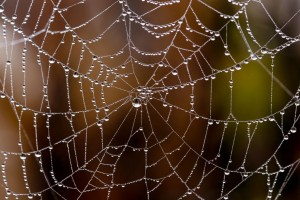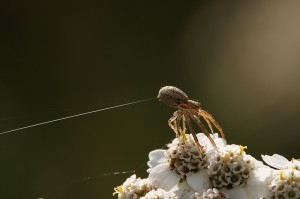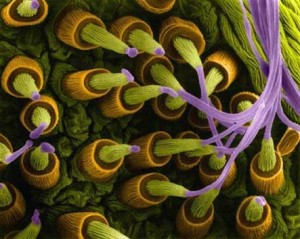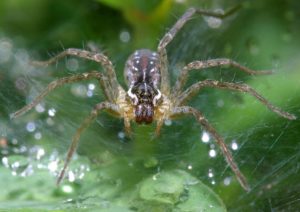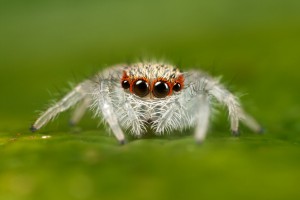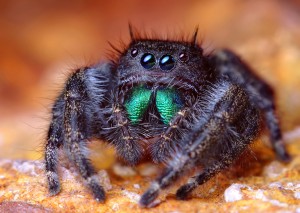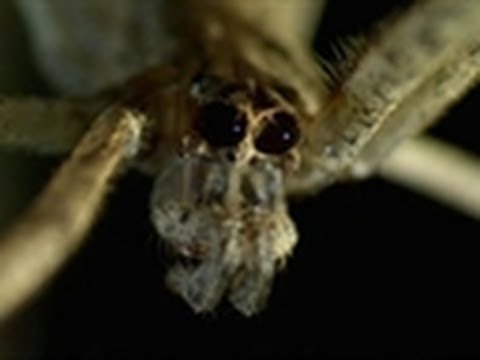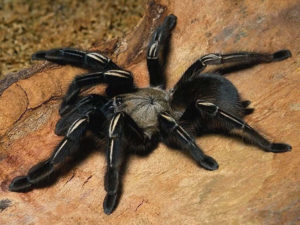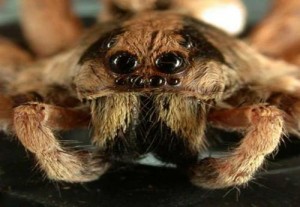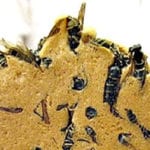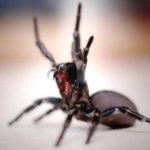10Communications Network
Webs are used to catch bugs—that’s like Spiders 101. But for the most part, arachnids have poor eyesight. So to know whether a bug is trapped in the web, or whether it’s just a carelessly flicked cigarette butt, spiders have to be able to read the different types of vibrations. Their web is like a giant harp, whose plucked strings sing of terrified moths and doomed ants. Some ground-dwelling spiders even set up their webbing to act as an alarm system. If an insect crosses over it, they can feel the vibrations and leap out of hiding to attack. The Corolla spider in particular has a unique way of rigging up a listening post. They live in the desert, where webs don’t last long against the sun, wind, and sand. So they surround their hole with quartz crystals and attach a thin filament of webbing to each one. Quartz is unique in that it passes on vibrations with hardly any loss. If a bug so much as brushes an antenna against one of the stones, the corolla spider will feel it transmitted down her lines and pounce. It’s sort of like when you were a kid and you attached strings to cans to talk to your buddy. The only difference here is that the guy on the other end has to die. But it’s not just all about hunting and killing. Lady spiders also have to be able to tell the difference between dinner and a gentleman caller. In some species the male will announce his intentions by plucking the female’s web to serenade her. Playing a good tune can mean the difference between passing on his genes and becoming a snack. Other spiders, like Portia fimbriata hunt their own kind. They specialize in learning the prey frequency that will get the attention of another spider. They will strum a web for hours until they find just the right note to lure down their eight-legged meal—dinner and a show.
9Flying
Spiders can fly—or at least some of them can. Tarantulas are too big and fat to get very far, but some of the smaller species can take to the skies. After they’re born, young spiders need to head out to find their own territories. And it seems the fastest and easiest way to cover ground is to fly there Mary Poppins style. The young spiders stick their rear into the air and let out a thin filament of web, called a gossamer dragline. Once it’s long enough, the wind snatches the strand and sends baby arachnid hurling off into the wild blue yonder. They can travel hundreds of miles this way. But what if an adult, who’s larger and heavier, wants to take off into the sky? Then they release several lines, which the wind fans out enough to act like a kite. The process is called ballooning or kiting. And, though mostly at the mercy of the wind, the aerial arachnid can actually exercise some control over how they fly—they can gain more altitude by releasing more gossamer. If they want to go down they simply reel in some of the lines. Spiders have been caught by people in hot air balloons thousands of feet up. So remember, the next time you step out into a breezy day, there could be a spider with your name on it sailing through the air.
8Repellents
There’s currently a race going on to see who can develop artificial spider silk first. The military is particularly interested because spider silk is three times stronger than Kevlar, but that’s just one of its many amazing properties. The medical field is equally eager to get hold of the arachnid-based goop. That’s because spider webs have antibacterial properties and they’re hypoallergenic, not to mention biodegradable. In fact, they’ve been used since ancient times to bandage wounds. Super-strong, thin bandages made out of webbing are coming, and the first company that can domesticate and farm giant spiders is going to be rich (or possibly doom us all). Preliminary tests also show that spider silk does not trigger any kind of immune response. Researchers are considering wrapping transplant organs in the stuff to decrease the risk of rejection by essentially hiding it from your body. So spider homes are naturally resistant to disease and fungus, but that’s not the only protection they get. Some spiders lace their webs with a chemical that repels ants. Golden orb spiders make large webs with thick support lines that ants can easily navigate. Considering the place is full of delicious dead bugs, ants should be harassing these spiders all the time. But in fact, they never come near the webs. It turns out that the chemical the spiders are using is similar to ant pheromones. And since ants rely primarily on chemical cues to navigate, spider webs are covered in a big flashing “danger” sign that keeps pests away. So not only will the webbing Band-Aids of the future be antibacterial, you won’t have to worry about ants attacking you either.
7Electro Netting
Everyone knows that spider webs are sticky. Bugs are hard pressed to escape from the gooey tendrils of an arachnid’s carefully lain trap. But the eight-legged hunter is still relying on a fly or bee to just blunder into it. It’s like fishing without bait—you’ve just got to hope you’re in the right place and that your lunch runs headfirst into your house. But as it turns out, spiders have a few tricks up their hairy sleeves to help even the odds. Recent research has revealed that they’re using electricity as a weapon. Many flying insects generate a positive charge. The rapid flapping of their wings around their fuzzy little bodies gives them the whole socks-right-out-of-the-dryer effect. Bees can generate a charge of up to 200 volts. How do spiders take advantage of this? Their webs are negatively charged. So guess what happens when a positively charged insect comes soaring past a negatively charged glue net? You’ve got a magnetic trap. The webbing will actually lurch toward the bug, so that they’ll get snared even if they’re just flying close to it. There is no pulling up at the last minute when dealing with a spider’s web. A fly won’t be able to buzz the tower Top Gun style and get away with it. And once they’re tumbling around the web, all the silk lines nearby will be attracted to the positively charged victim too. Spiders have managed to turn static cling into a hunting tool.
6Safety Lines
Among the countless potential applications for spider silk, using it as rope is about the most obvious. Safety lines made out of spider silk would be virtually unbreakable. That’s what spiders use them for after all. But spider silk has some unique properties that we can’t even match. Some jumping spiders can leap 50 times their own body length. That’s farther than some crickets. For safety, jumping spiders let out a dragline behind them. If they miss their prey or target, they just fall and swing around. It’s spider-attack bungee jumping. So arachnids use safety harnesses, but they can also pull tricks with them that no human can match. While flying through the air and letting out silk behind them, spiders can put on the brakes. If they’re coming in too fast they can clench down and slow their speed. In this way they can also control their attack angle and make minor adjustments on approach. It even prevents them from tumbling when they land. No other animal can slow down or change angle mid-pounce like that. And the elastic properties of silk are such that it releases the excess energy as heat as it stretches. That means it doesn’t snap back into shape afterward like a rubber band would. So instead of getting flung back like a cartoon coyote, the spider just glides in gently. It’s a featherlight landing without any of the sharp jerks that man-made material suffers from.
5Crushing
Spiders are soup eaters. Once a bug gets tangled in a web, the itsy bitsy spider will come along and inject it with venom, both to kill it and to begin the digestion process by turning its insides into a smoothie. However, uloborid spiders are unique in that they don’t have venom glands. That should mean that they’d have to wait for their victims to die of starvation or boredom before it’s safe to get close to them (you don’t want to risk getting stung by a bee while you’re trying to drool digestive juices over it). But spiders aren’t really known for their patience. Since uloborid spiders can’t intoxicate their prey, they use other, less humane ways to deal out death. They repeatedly wrap a captured insect in webbing, over and over and over, sometimes for as long as an hour. After, oh, around 28,000 loops and 400 feet of silk the bug is dead, either through suffocation or because it’s been crushed to death in the ever-tightening cocoon. Uloborids use their webbing to create a straitjacket of death. They’re like the pythons of the arachnid world.
4Net Casting
Most spiders are content to wait. These couch potatoes of the arachnid world weave an intricate marvel of nature, and then sit there hoping a dumb bug stumbles into it while they kick their feet up. Ogre-faced spiders do things completely differently. They’re the daredevil, X Games–loving, Red Bull–swilling, adrenaline addicts of the arachnid world. First, the spider makes a net. Not a web, but a non-adhesive elastic net that it holds in four of its legs. That’s why one of its other names is the “Gladiator Spider”—because it’ll launch itself at bugs and try to entangle them in its net. And when it’s not using its net to entangle helpless passersby, it’ll hang the thing up. It’s a spider that not only makes and wields its own weapon, but that has a closet to keep it in. But the ogre-faced spider isn’t just running around trying to entangle random bugs. No, there’s a system. Hanging head-down over a popular insect path with its net, this hunter will also mark the target area by releasing fecal droppings that dry white. Any bug that passes next to the spider poop is in the kill zone. How fast can the net-wielding arachnid move? One strike was clocked at one-thousandth of a second.
3Sex
Xysticus cristatus is a crab spider with peculiar tastes in the bedroom. Spider mating is pretty dangerous for the most part. Females are typically bigger than the males and they’ve been known to snack on their boyfriends. Several species have interesting mating habits, from dancing and stroking to gift giving and, of course, murder. As varied and exotic as arachnid courtship can be, Xysticus cristatus is pretty unique. To start off their night of passion the male runs up and grabs the female by the leg (which is a pretty gutsy move in and of itself). She freaks out a little, but gradually calms down. The male spider then caresses her with his legs while he uses his silk to tie her up. Yes, some spiders are into bondage. The female spider doesn’t fight or struggle as he secures her, even though she could break free of the silk if she wanted too. In fact, after the male spider has done the deed, he just leaves her there, tied down to whatever leaf or stick they were using as a love pad. It’s up to her to get loose. She easily does, but only once the male is finished. It’s the spider version of 50 Shades of Grey.
2Webbing Shooters
Everyone loves Spider-Man, right? The way he leaps around insulting and beating up the bad guys with his spider-themed superpowers. The only problem is that none of his abilities are realistic. There is no psychic spider sense, arachnids don’t just magically cling to any surface while wearing footy pajamas, and most importantly, spiders don’t have web shooters. That’s completely implausible, right? No spider can hurl webbing through the air at an opponent . . . with the single exception of spitting spiders. They actually have web shooters that put Spider-Man to shame. All spiders eject silk from a spinneret that’s found on their rear. But arachnids of the Scytodidae family have developed a nifty trick that few others can match. They can shoot sticky silk out of their fangs. And they don’t just dribble it out, they launch it out of each fang like a Super Soaker. They can immobilize prey with their web slingers, just like Spider-Man. They can even alternate between firing one or the other (or both) at the same time. The only real difference is that the spider’s fang webbing also has the added benefit of being venomous. So they fling toxic webbing out of their faces. Beat that Spidey!
1Climbing Socks
To climb up walls, most spiders use over 600,000 tiny hairs located on the bottoms of their feet. These hairs are so small that they can grab hold of a surface using molecular forces (the van der Waals force is an electrostatic force that acts between two molecules that are within one nanometer). This is how spiders can walk up virtually any surface. But that doesn’t explain larger arachnids like tarantulas. How do they get around? Tarantulas are too big to cheat physics with magic hairy static-cling feet. So they came up with another method that you may have heard of already in this list—spider silk. Tarantulas can squirt microscopic strands of silk out of their feet. By putting a tarantula on a clean sheet of glass and then trying to shake it off, researchers were able to find splatters of webbing where its feet were. At first other spiderologists were doubtful—There was no way spiders could shoot webbing out of their feet. Out of their butt? Sure. Out of their fangs? Sometimes. But web slingers built into feet just seemed dumb. Until scientists looked at the feet of a few dead tarantulas under an electron microscope and proved it. They found special spigots with silk coming out of them. Tarantulas have little silk nozzles right on the bottom of their walking nubs that helps them climb surfaces they ordinarily shouldn’t be able too. So basically, spiders can expel silk from just about any part of their body. Monte Richard II writes for Cracked.com and you can also check out his blog.
